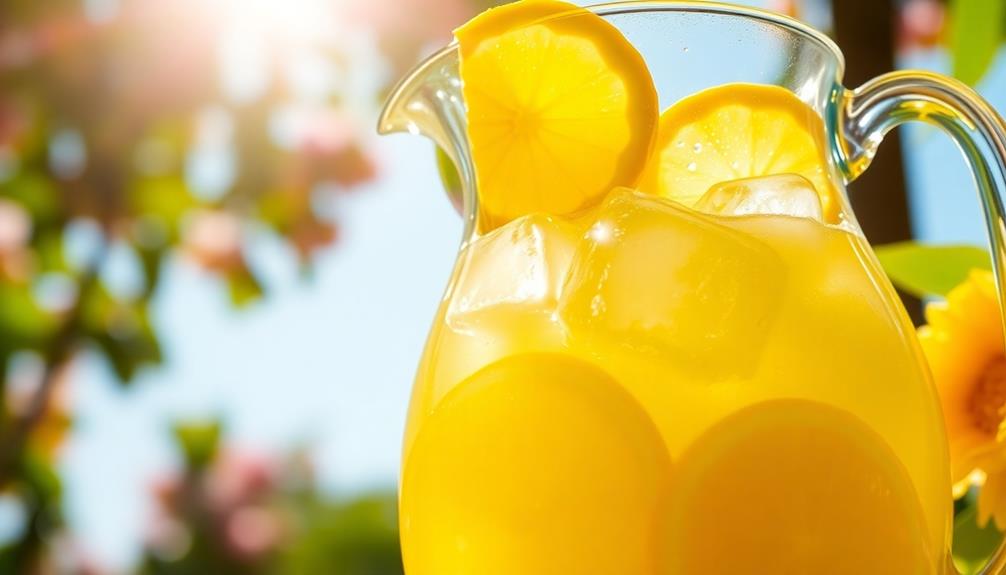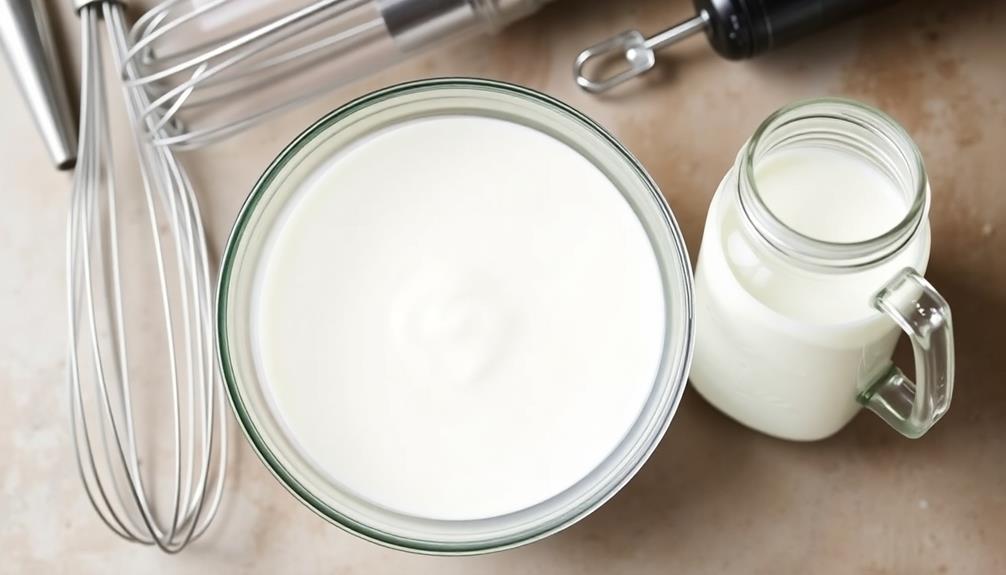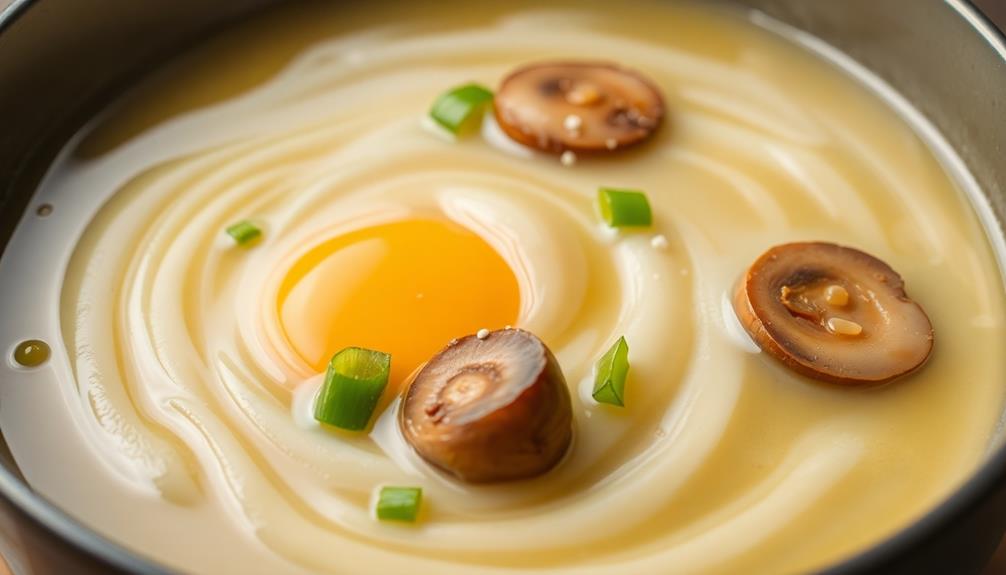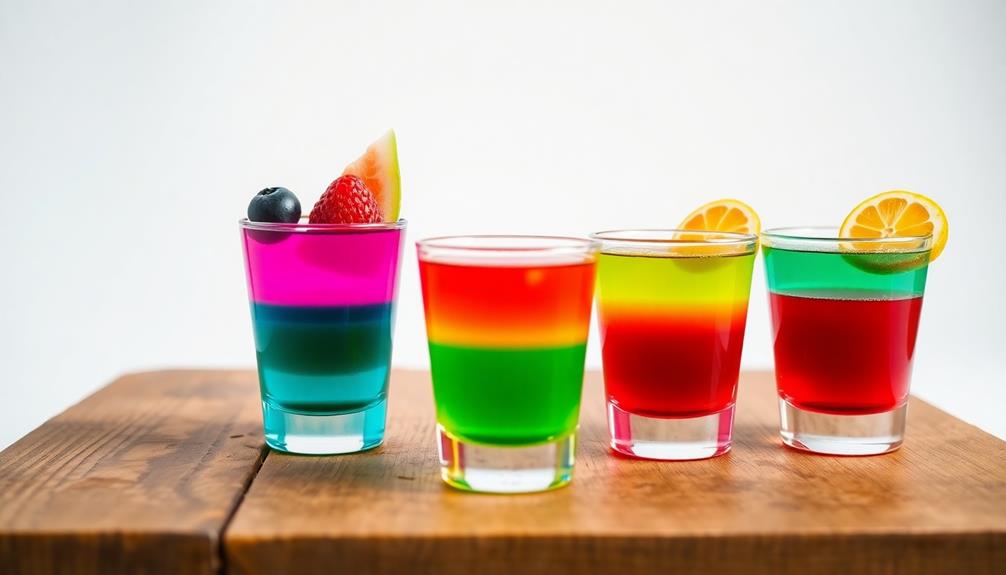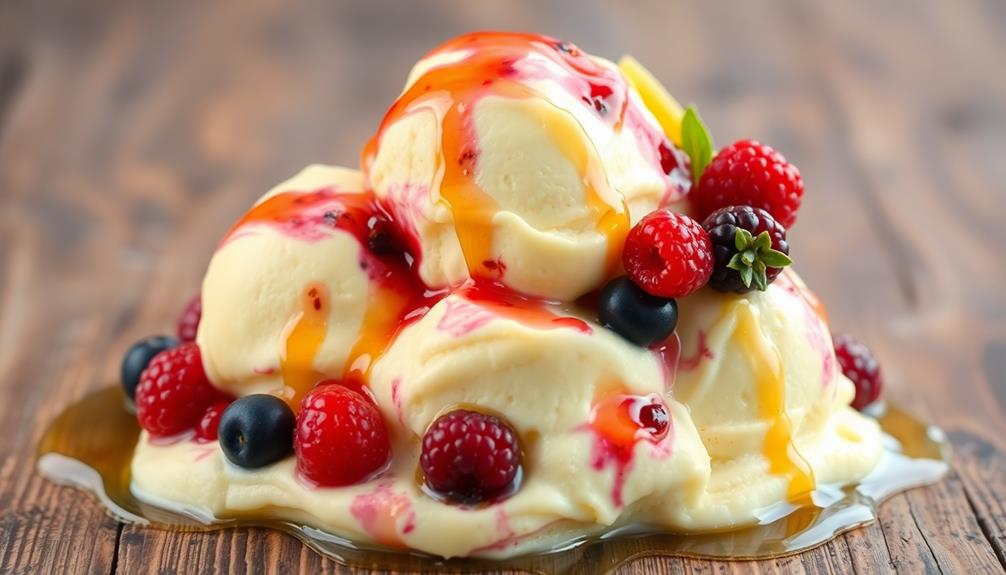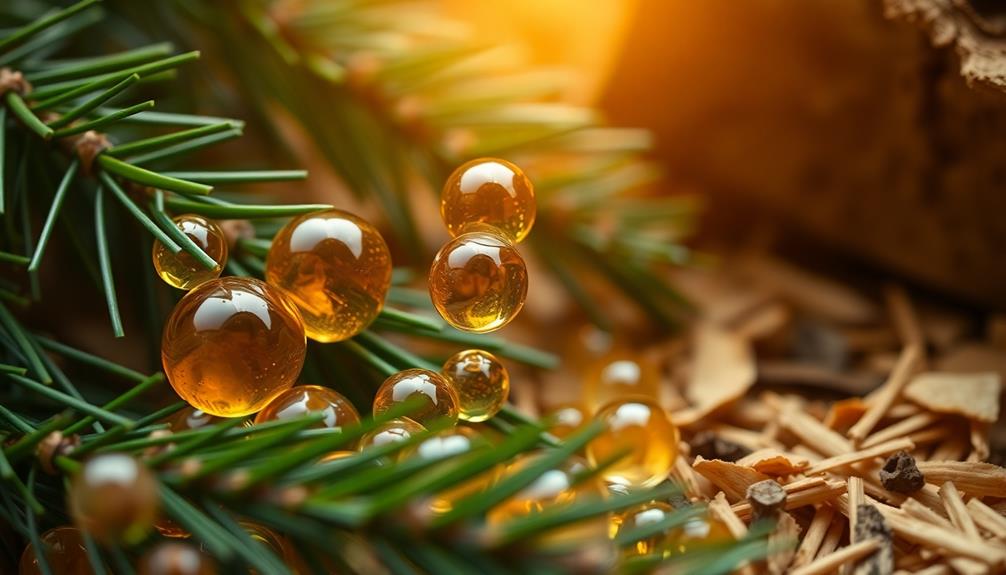On a hot summer day, you'll love whipping up a batch of refreshing homemade lemonade. This classic thirst-quencher has roots dating back to ancient Egypt, and its popularity has only grown over the centuries. Start by squeezing some fresh lemons, then add sugar to balance the tart and sweet flavors. Stir until the sugar dissolves, then chill with ice for maximum refreshment. Garnish with a lemon slice or mint sprig for a touch of flair. Homemade lemonade offers far superior taste compared to store-bought, plus you'll gain valuable culinary skills – the perfect way to beat the summer heat.
Key Takeaways
- Homemade lemonade offers superior flavor compared to store-bought options, allowing for personalized taste preferences.
- The classic lemonade recipe includes fresh lemon juice, sugar, and cold water, with flexible adjustments for desired sweetness.
- Preparing lemonade involves squeezing fresh lemons, adding sugar to taste, and chilling the mixture with ice cubes.
- Lemonade's visual appeal can be enhanced by garnishing with lemon slices or mint, creating an impressive presentation.
- Mastering lemonade-making is a valuable culinary skill that can be applied to various refreshing beverage recipes for year-round enjoyment.
History

According to historical records, lemonade has been enjoyed by people for centuries. The origins of this refreshing beverage can be traced back to ancient Egypt, where a drink made from lemons, honey, and water was consumed as early as the 12th century.
Over time, lemonade recipes spread throughout the Mediterranean region and eventually made their way to Europe.
In the 17th century, lemonade became increasingly popular in France, where street vendors known as "limonadiers" would sell the tangy drink to thirsty Parisians. The recipe evolved, incorporating sugar to balance the tartness of the lemons.
By the 18th century, lemonade had become a fashionable drink among the European elite, often served at formal events and social gatherings.
Today, lemonade remains a beloved summer staple, quenching thirst and bringing a taste of sunshine to any occasion. Its timeless appeal continues to captivate people around the world, making it a refreshing and enduring part of culinary history.
Recipe

Lemonade is a refreshing and classic summertime beverage that's easy to make at home. The combination of tart lemon juice, sweet sugar, and cool water creates a balanced and satisfying drink that can be enjoyed on its own or used as a mixer for cocktails.
Making homemade lemonade is a simple process that allows you to control the ingredients and customize the flavor to your liking. The following recipe produces a classic lemonade that can be easily scaled up or down to accommodate your needs.
- 6 lemons, juiced (approximately 3/4 cup of lemon juice)
- 3/4 cup granulated sugar
- 4 cups cold water
In a pitcher, combine the lemon juice and sugar. Stir until the sugar is fully dissolved. Add the cold water and stir to combine. Taste and adjust the sweetness or acidity as desired. Serve over ice and garnish with lemon slices, if desired.
For a smoother texture, you can blend the lemon juice and sugar until the sugar is fully dissolved before adding the water. Chilling the lemonade in the refrigerator for at least 30 minutes before serving will also help to meld the flavors and create a more refreshing drink.
Experiment with different types of sugar, such as honey or agave, to find your perfect lemonade recipe.
Cooking Steps

First, squeeze some fresh lemons to get the juice.
Next, add sugar to the juice and stir until the sugar dissolves completely.
Step 1. Squeeze Fresh Lemon Juice

Squeeze the fresh lemons with a citrus juicer or your hands to extract the tangy juice. You'll need about 3-4 medium-sized lemons to make a refreshing pitcher of lemonade.
Rolling the lemons on the counter before cutting them in half can help release more of their juicy goodness, just like how you might enjoy Birthday Cake Ice Cream for a celebratory treat.
Squeeze each lemon half firmly, collecting the tart liquid in a bowl. Try to avoid letting any seeds slip into the mixture.
Once you've juiced all the lemons, give the liquid a quick stir. Grab a mesh strainer and pour the lemon juice through it to catch any remaining pulp or seeds.
Your fresh, vibrant lemon juice is now ready to be sweetened and diluted with water. Remember, the more juice you're able to extract, the better the lemonade will taste.
With just a few simple steps, you can enjoy the classic taste of homemade lemonade on a hot summer day.
Step 2. Add Sugar to Taste

With the fresh lemon juice ready, it's time to start sweetening your homemade lemonade. The amount of sugar you add will depend on your personal taste preferences, so start with a small amount and gradually increase until you achieve the perfect balance of tart and sweet.
For an added health boost, consider incorporating fresh ginger juice for its metabolism-enhancing properties, which can elevate your homemade lemonade to a refreshing detox drink detoxifying juices.
Begin by adding 2-3 tablespoons of granulated sugar to your lemon juice. Stir vigorously until the sugar has fully dissolved. Taste the lemonade and add more sugar, a teaspoon at a time, until you're satisfied with the flavor. Remember, you can always add more sugar, but it's harder to fix an overly sweet lemonade.
For a healthier alternative, try using honey or agave nectar instead of white sugar. Start with 2 tablespoons and adjust to your liking. The natural sweeteners will add a unique depth of flavor to your homemade lemonade.
Once you've found the perfect sweetness, your lemonade is ready to be enjoyed. Serve over ice and garnish with a lemon slice for a refreshing summer treat.
Step 3. Stir to Dissolve Sugar

Go ahead and stir the lemon juice vigorously until the sugar has fully dissolved. This simple step ensures the sweetener is evenly distributed throughout your lemonade, creating a smooth, balanced flavor.
Grab a sturdy spoon and make circular motions, scraping the sides and bottom of your pitcher or container. Keep stirring until you no longer see any granules of sugar—this usually takes about 1-2 minutes.
Be patient and thorough, as properly dissolving the sugar is key to a refreshing, drinkable lemonade. Once the sugar has fully incorporated, give the mixture a final stir to double-check. The liquid should appear clear and uniform.
Taste a small sip to confirm the sweetness level matches your preference. If needed, you can always add a touch more sugar and stir again.
With the sugar dissolved, your lemonade base is ready to chill and serve over ice. Enjoy the sweet-tart goodness on a hot summer day!
Step 4. Add Ice Cubes

Once the sugar has fully dissolved, it's time to add ice cubes to your lemonade. This step is crucial to achieving the perfect, refreshing balance of sweet and tart.
Grab a handful of ice cubes and gently drop them into your pitcher or glass. You'll hear the satisfying sizzle as the cold cubes meet the warm lemonade. As the ice begins to melt, it will dilute the concentrate, creating a smooth, chilled beverage.
Be sure to add enough ice to chill the lemonade, but not so much that it waters down the flavor. Aim for about 1 cup of ice per 8 ounces of lemonade.
Stir the mixture gently to encourage the ice to melt evenly. Once the lemonade reaches your desired temperature, it's ready to serve and enjoy. The combination of the sweet, tangy lemon and the refreshing coldness will be a true taste of summer.
Adjust the amount of ice to suit your personal preference and the needs of your thirsty guests.
Step 5. Serve Cold

Typically, you'll want to serve the lemonade immediately after adding the ice. The cold temperature is essential for creating a refreshing and thirst-quenching beverage. When the ice hits the lemon juice, it gives the lemonade a crisp, chilled taste that's perfect for hot summer days.
Be sure to pour the lemonade over the ice, allowing the cubes to float in the glass. This not only looks visually appealing, but it also helps to keep the drink cold as you sip.
You can even consider adding a few extra ice cubes to the pitcher or serving jug to ensure the lemonade stays icy cold from the first glass to the last.
For an extra special touch, you can garnish each glass with a lemon slice or a sprig of mint. This adds a pop of color and a subtle hint of freshness.
Serve the lemonade immediately and enjoy the cool, refreshing flavor on a warm afternoon.
Final Thoughts

With a refreshing glass of homemade lemonade in hand, it's time to reflect on the journey of creating this classic thirst-quencher.
Making lemonade from scratch may seem like an extra step, but the end result is well worth the effort. Not only does it taste infinitely better than the store-bought stuff, but the process is surprisingly simple and customizable to your taste buds.
Whether you prefer your lemonade tart and zingy or sweet and mellow, the flexibility of this recipe allows you to experiment until you find the perfect balance.
And don't forget the power of presentation – a wedge of lemon or a sprig of mint can elevate your lemonade from ordinary to extraordinary.
As you sip and savor your homemade creation, take pride in the fact that you've mastered a timeless summertime classic.
With this newfound skill, the possibilities for refreshing, thirst-quenching beverages are endless.
Cheers to a job well done!
Frequently Asked Questions
Can I Make Lemonade With Other Citrus Fruits?
Absolutely, you can make lemonade with other citrus fruits like oranges, limes, or grapefruit. The key is to adjust the sweetener to balance the tartness of the fruit. Get creative and experiment with different combinations for a refreshing twist on classic lemonade.
How Long Does Homemade Lemonade Last in the Fridge?
Homemade lemonade typically lasts 3-5 days in the refrigerator when stored properly in an airtight container. The acidity and lack of preservatives mean it won't last as long as store-bought varieties, so enjoy it within a week for the best taste.
Can I Use Artificial Sweeteners Instead of Sugar?
Sure, you can use artificial sweeteners instead of sugar in your homemade lemonade. Just be mindful of the sweetness level and adjust the amount to your taste preference. Artificial sweeteners can provide a sugar-free alternative.
Is Lemonade Safe for Pets to Drink?
Lemonade isn't safe for pets to drink. The citric acid and sugar content can upset their stomachs and potentially lead to health issues. It's best to stick to water or pet-safe beverages when hydrating your furry friends.
Can I Make Lemonade in Advance for Parties?
You can absolutely make lemonade in advance for parties! Just store it in the fridge and give it a quick stir before serving. It'll stay fresh and flavorful for up to a week.

